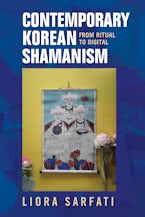- Home
- Contemporary Korean Shamanism
Preparing your PDF for download...
There was a problem with your download, please contact the server administrator.
Contemporary Korean Shamanism
From Ritual to Digital
Published by: Indiana University Press
228 Pages, 15 b&w illus.
- eBook
- 9780253057198
- Published: August 2021
$27.99
Other Retailers:
Once viewed as an embarrassing superstition, the theatrical religious performances of Korean shamans—who communicate with the dead, divine the future, and become possessed—are going mainstream. Attitudes toward Korean shamanism are changing as shamanic traditions appear in staged rituals, museums, films, and television programs, as well as on the internet.
Contemporary Korean Shamanism explores this vernacular religion and practice, which includes sensory rituals using laden altars, ecstatic dance, and animal sacrifice, within South Korea's hypertechnologized society, where over 200,000 shamans are listed in professional organizations. Liora Sarfati reveals how representations of shamanism in national, commercialized, and screen-mediated settings have transformed opinions of these religious practitioners and their rituals.
Applying ethnography and folklore research, Contemporary Korean Shamanism maps this shift in perception about shamanism—from a sign of a backward, undeveloped Korea to a valuable, indigenous cultural asset.
Accessing Audiovisual Materials
Acknowledgments
Note on Transliteration
Introduction
1. Gods on Stage: A Mediated Performance
2. The Changing Image of Musok in Films
3. Agendas, Power, and Ideology in Museum Displays of Korean Shamanism
4. Getting to Know a Korean Shaman through Television Representations
5. Shamans Online: Internet Promotion of Musok Practitioners
Conclusion: From Ritual to the World Wide Web and Back
References
Index
Liora Sarfati is Senior Lecturer (Associate Professor) in the Department of East Asian Studies at Tel Aviv University.
"Contemporary Korean Shamanism provides a fresh, contemporary approach to Korean shamanism that both describes and analyzes the 'vernacular religion' from a theoretical approach suited to this highly mediated form of religious practice."
~Richard D. McBride II, author of Domesticating the Dharma: Buddhist Cults and the Hwaŏm Synthesis in Silla Korea
"A strikingly original contribution to our understanding of Korean culture today."
~Donald Baker, author of Korean Spirituality
"Professor Liora Sarfati masterfully demonstrates how and why shamanism in contemporary Korea is not only the most widely dispersed religion, even more widespread than Christianity and Buddhism, but also thrives through the virtual media of a hyper-wired society. Professor Sarfati's tour de force makes an invaluable contribution to the field of Shamanism and will be a must-read for anyone interested in religious, media, folklore, and material studies."
~Kim Hwansoo, author of The Korean Buddhist Empire: A Transnational History, 1910-1945
"Liora Sarfati recognizes the sea change in shamanic practice taking place in South Korea stemming from IT innovation and the vernacular religion's historical adaptability. The impact of this research will be paramount to advancing our knowledge not only of Korean shamanism, but also of the role of new media in transforming religious practices in general."
~Kyoim Yun, author of The Shaman's Wages: Trading in Ritual on Cheju Island
"In considering contemporary Korean shamanism through the lens of its mediations, Liora Sarfati refreshes an old anthropological topic. Shamans' practices coexist with the presentation of shamanism on stage, in films, in museums, on television, and on the internet. By treating practice and representations not as different orders of reality but as elements in an interconnected network, Sarfati is able to trace the circuits and feedback loops that are characteristic of shamanism today."
~Robert Oppenheim, author of Kyongju Things: Assembling Place
"Contemporary Korean Shamanism is ethnographically based, uses a wide range of sources and materials, and contains extensive interviews with shamans both female and male (Korean shamans are predominantly female). The book does not discuss in detail specific individual rituals or shamanistic traditions, all of which can be found in other sources. It is principally about the transformation of the image of a religious tradition and how this occurred. As such, it is of interest not only to ethnographers, folklorists, and students of religion, but also to scholars concerned with social and cultural change."
~James H. Grayson, University of Sheffield, Folklore
"Based on extensive fieldwork and study of musok, Contemporary Korean Shamanism offers keen insights into the many factors that determine perceptions of an important vernacular religious tradition in modern South Korean society. It is an important addition to recent English-language scholarship, providing a different and very welcome perspective on Korean shamanism."
~Charles La Shure, Seoul National University

